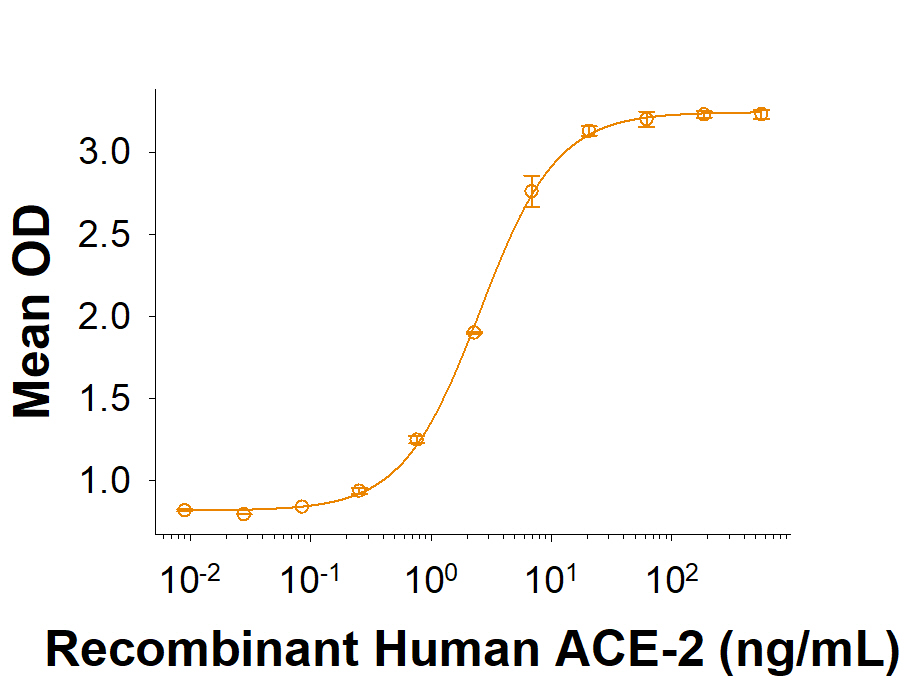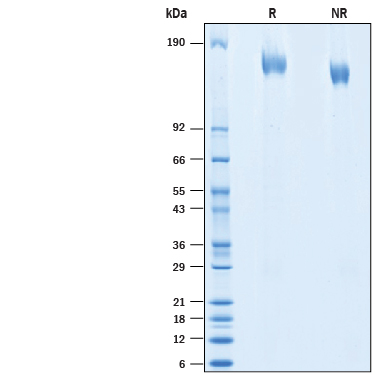Recombinant SARS-CoV Spike His-tag Protein, CF Summary
Product Specifications
Analysis
Product Datasheets
Carrier Free
CF stands for Carrier Free (CF). We typically add Bovine Serum Albumin (BSA) as a carrier protein to our recombinant proteins. Adding a carrier protein enhances protein stability, increases shelf-life, and allows the recombinant protein to be stored at a more dilute concentration. The carrier free version does not contain BSA.
In general, we advise purchasing the recombinant protein with BSA for use in cell or tissue culture, or as an ELISA standard. In contrast, the carrier free protein is recommended for applications, in which the presence of BSA could interfere.
10683-CV
| Formulation | Lyophilized from a 0.2 μm filtered solution in PBS with Trehalose. |
| Reconstitution | Reconstitute at 500 μg/mL in PBS. |
| Shipping | The product is shipped at ambient temperature. Upon receipt, store it immediately at the temperature recommended below. |
| Stability & Storage: | Use a manual defrost freezer and avoid repeated freeze-thaw cycles.
|
Scientific Data
 View Larger
View Larger
Recombinant SARS-CoV Spike His-tag (Catalog # 10683-CV) binds Recombinant Human ACE-2 His-tag (933-ZN) in a functional ELISA.
 View Larger
View Larger
2 μg/lane of Recombinant SARS-CoV Spike His-tag (Catalog # 10683-CV) was resolved with SDS-PAGE under reducing (R) and non-reducing (NR) conditions and visualized by Coomassie® Blue staining, showing bands at 150-166 kDa.
Reconstitution Calculator
Background: Spike
SARS-CoV was discovered in association with cases of severe acute respiratory syndrome (SARS) that infected more than 8,000 persons with over 900 fatalities worldwide in 2002-2003 (1). It belongs to a family of viruses known as coronaviruses that also include MERS and SARS-CoV2 that causes the global pandemic coronavirus disease 2019 (Covid-19). Coronavirus is commonly comprised of four structural proteins: Spike protein(S), Envelope protein (E), Membrane protein (M) and Nucleocapsid protein (N) (1). SARS-CoV S Protein is a trimeric type-I membrane glycoprotein that mediates membrane fusion and viral entry. As with most coronaviruses, proteolytic cleavage of the S protein into two distinct peptides, S1 and S2 subunits, is required for activation. The S1 subunit is focused on attachment of the protein to the host receptor while the S2 subunit is involved with cell fusion (2-4). A metallopeptidase, angiotensin-converting enzyme 2 (ACE-2), has been identified as a functional receptor for SARS-CoV through interaction with a receptor binding domain (RBD) located at the C-terminus of S1 subunit (5, 6). Based on amino acid (aa) sequence homology, the S protein of SARS-CoV shares 75% and 31% homology with S protein of SARS-CoV2 and MERS, respectively. Before binding to the ACE-2 receptor, structural analysis of the S1 trimer shows that only one of the three RBD domains in the trimeric structure is in the "up" conformation. This is an unstable and transient state that passes between trimeric subunits but is nevertheless an exposed state to be targeted for neutralizing antibody therapy (7). Antibodies to S protein especially the S1 subunit of SARS-CoV have been shown to inhibit interaction with the ACE-2 receptor, confirming S1 subunit as an attractive target for vaccinations or antiviral therapy (8).
- Rota, P.A. et al. (2003) Science 300:1394.
- Bosch, B.J. et al. (2003). J. Virol. 77:8801.
- Belouzard, S. et al. (2009) Proc. Natl. Acad. Sci. USA 106:5871.
- Millet, J.K. and G. R. Whittaker (2015) Virus Res. 202:120.
- Li, W. et al. (2003) Nature 426:450.
- Wong, S.K. et al. (2004) J. Biol. Chem. 279:3197.
- Ortega, J.T. et al. (2020) EXCLI J. 19:410.
- Du, L. et al. (2009) Nat. Rev. Microbiol. 7:226.
Citations for Recombinant SARS-CoV Spike His-tag Protein, CF
R&D Systems personnel manually curate a database that contains references using R&D Systems products. The data collected includes not only links to publications in PubMed, but also provides information about sample types, species, and experimental conditions.
2
Citations: Showing 1 - 2
Filter your results:
Filter by:
-
SARS-CoV-2 spike does not interact with the T cell receptor or directly activate T cells
Authors: Gaglione, SA;Rosales, TJ;Schmidt-Hong, L;Baker, BM;Birnbaum, ME;
Proceedings of the National Academy of Sciences of the United States of America
Species: Human
Sample Types: Recombinant Protein
Applications: Bioassay -
Cross-reactive antibodies elicited to conserved epitopes on SARS-CoV-2 spike protein after infection and vaccination
Authors: ES Geanes, C LeMaster, ER Fraley, S Khanal, R McLennan, E Grundberg, R Selvaranga, T Bradley
Scientific Reports, 2022-04-20;12(1):6496.
Species: Human
Sample Types: Serum
Applications: ELISA Capture
FAQs
No product specific FAQs exist for this product, however you may
View all Proteins and Enzyme FAQsReviews for Recombinant SARS-CoV Spike His-tag Protein, CF
There are currently no reviews for this product. Be the first to review Recombinant SARS-CoV Spike His-tag Protein, CF and earn rewards!
Have you used Recombinant SARS-CoV Spike His-tag Protein, CF?
Submit a review and receive an Amazon gift card.
$25/€18/£15/$25CAN/¥75 Yuan/¥2500 Yen for a review with an image
$10/€7/£6/$10 CAD/¥70 Yuan/¥1110 Yen for a review without an image
